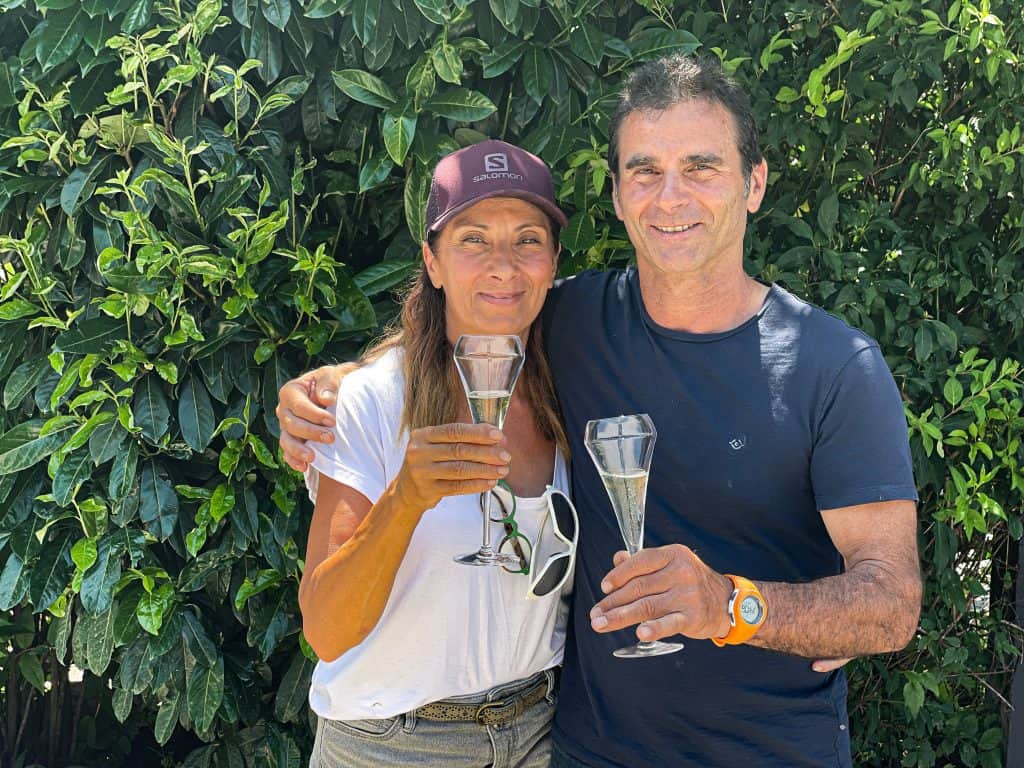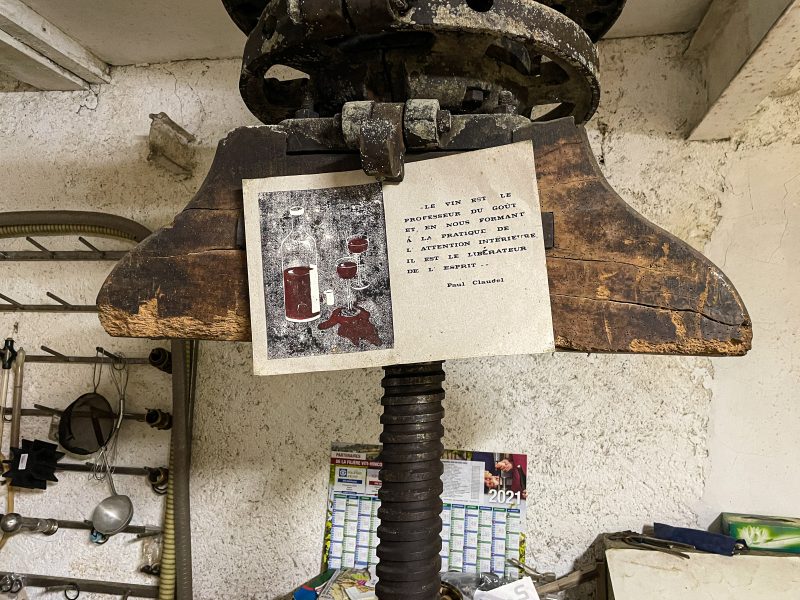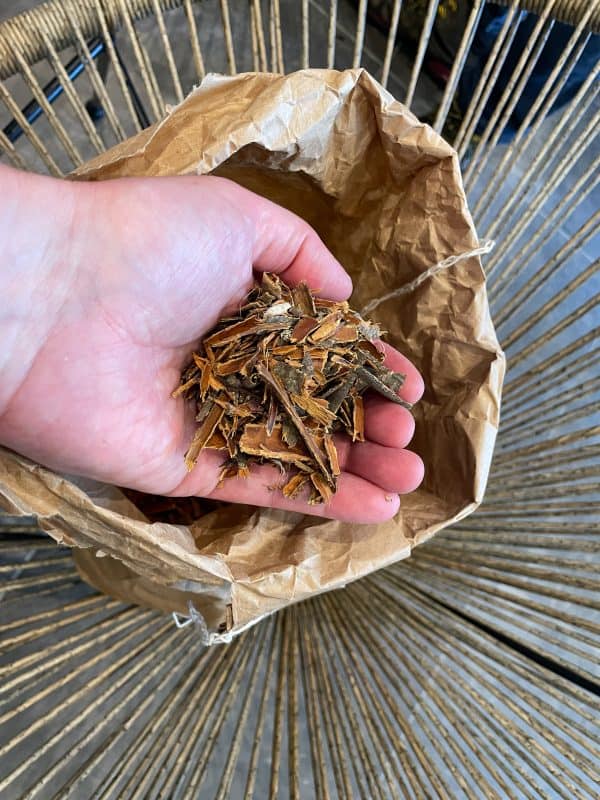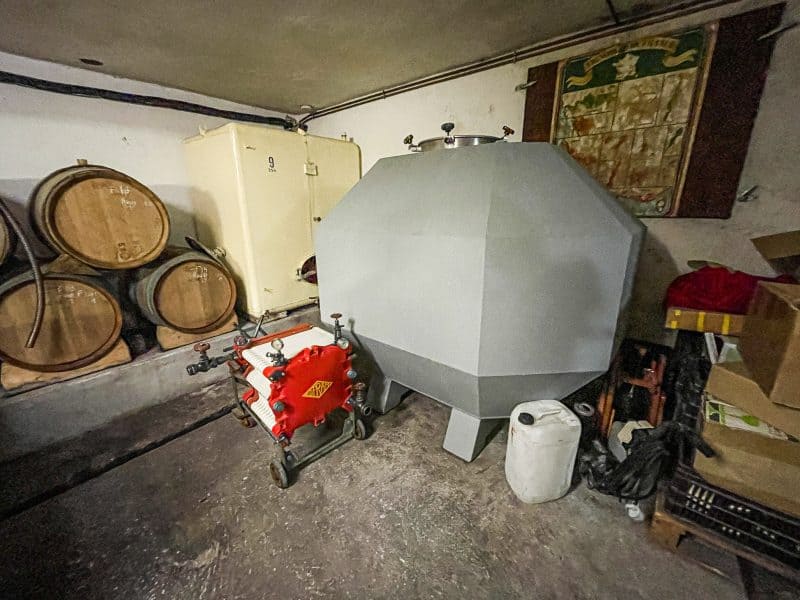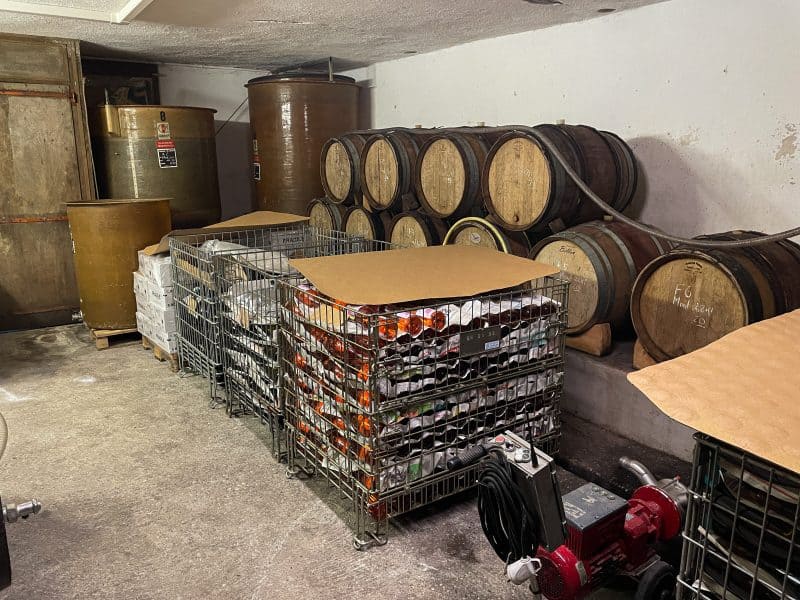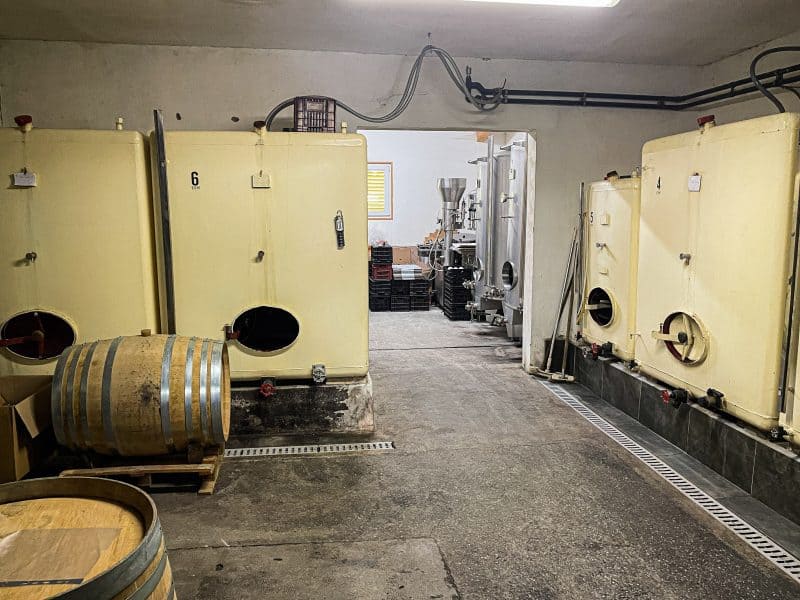I followed Google Maps through the little Haut-Savoie village of Frangy and up a steep hillside into the vineyards, eventually to be deposited at the end of a gravel driveway labeled with the number where the internet suggested I’d find the tiny winery of Bruno Lupin.
Emerging from my rental car, I was greeted by a genial old man who despite his smile, wanted to know what the hell I was doing in his driveway. At least, that’s what I thought he was (politely) asking me in French, a language I cannot be said to speak, only to butcher.
The next 2 minutes of conversation were the stuff of so many slapstick comedy routines involving two parties earnestly trying to understand each other in the absence of a common language. Eventually, I gathered that I had indeed found Lupin, but instead of Bruno, I had the pleasure of addressing his father, Francois. I had arrived at his childhood home, still occupied by the elder Lupin, in the midst of a very old vineyard planted by and named for Francois’ father Jean, whom everyone called Pepe.
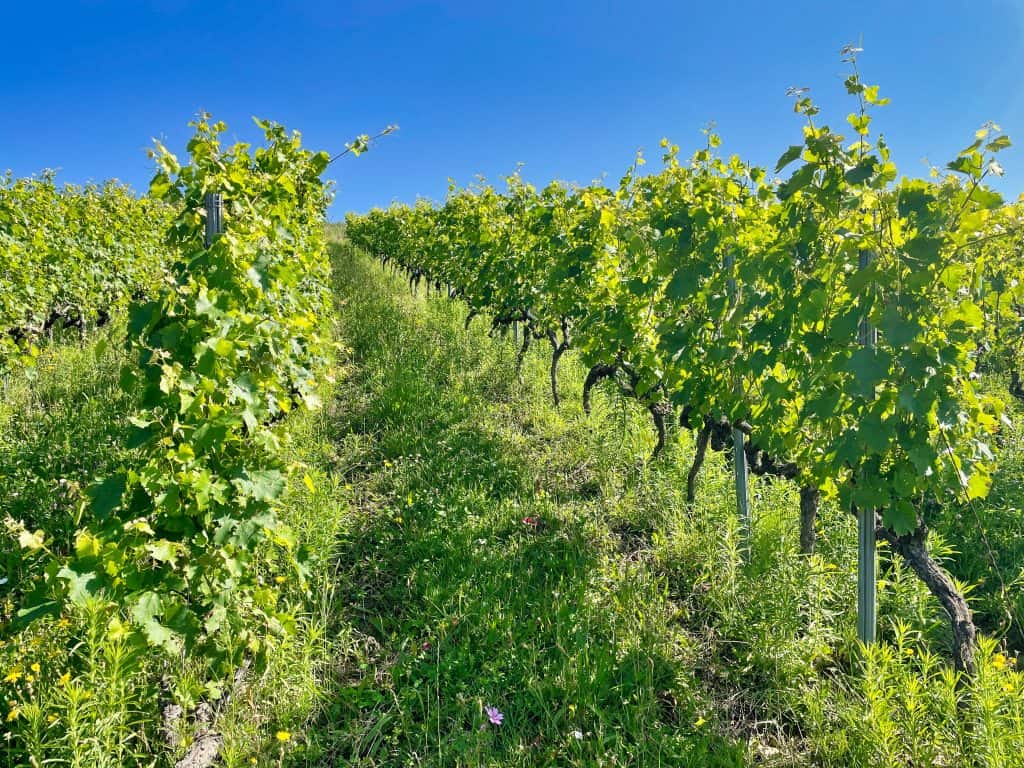
From this small, steep plot of Altesse, Bruno Lupin (and his father before him) has long made a flagship bottling of deeply mineral, silky, seductive wine that sings of the region’s morainic clay-limestone soils and crisp pre-alpine sunlight.
Eventually, through a combination of hand gestures and a trickle of comprehension squeezed from my broken French, I gathered that the younger Lupin I had come to see that morning would be awaiting me just down the hill at the site of his modest winery and tasting room, converted from an ancient chicken coop and feed store in the center of town.
Deep Roots
The Lupin family has been associated with the little village of Frangy for more than a century, but when Bruno Lupin came of age he had no intention of working in the family wine domaine. Instead, after his Enology studies in Beaune, he went to work for Cave de Genève, a large co-op winery in Switzerland, where he assumed the role of Chief of Vinification and spent almost 15 years making very large quantities of wine with a high degree of sanitation, precision, and repeatability.
In 1998, at the age of 35, Lupin returned to his hometown to take over from his father, after it became clear that neither his brothers nor his sister were going to keep the family business running. In the process, he left behind nearly everything he had been doing from a winemaking perspective in Switzerland, save perhaps a keen attention to detail.
“In Switzerland we produced a lot of different wines, and the company lost itself in diversity,” says Lupin. “When I decided to come home I wanted to keep things simple.”
Lupin immediately began phasing out all herbicide and pesticide use in his family’s 15 acres of vineyards and left behind all interventions in the cellar save temperature control, occasionally preventing malolactic conversion, and the addition of sulfur dioxide when needed to keep his wines fresh.
For the past 25 years, Lupin has been focused almost entirely on one plot of land and one grape, the variety Altesse that many believe may have originated in the region. This long history with the grape is perhaps one of the reasons that Frangy is a cru—one of only 4 villages in the Savoie region that are allowed to attach their names to bottles of Roussette de Savoie, the local AOC designation for Altesse.
Lupin’s plot sits at the heart of a hillside named Les Aricoques, which has been associated with some of the highest quality Altesse made in the Savoie for a very long time.
“Altesse requires an incredible amount of attention,” says Lupin. “It has a lot of vigor, and so if you want the highest quality you have to work extremely hard in the vineyard.”
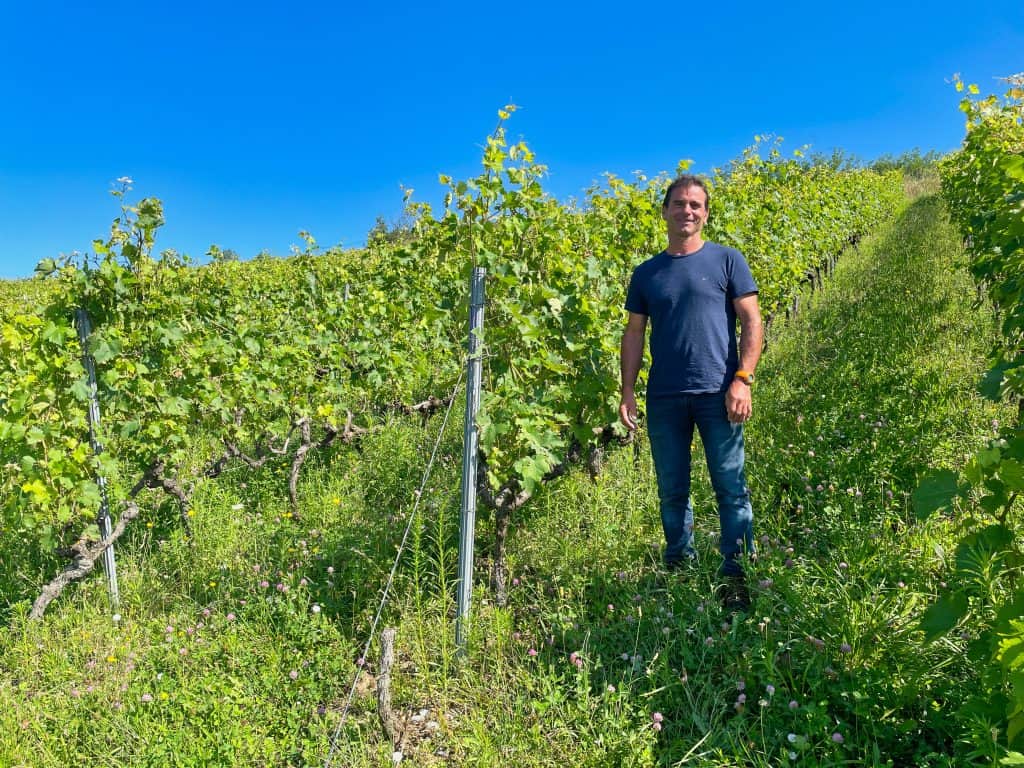
Lupin’s seeming mastery of the variety has put him much in demand as consultant, troubleshooter, and overall expert in the region. Recently a non-profit decided to resurrect an historic vineyard bordering nearby Lake Annecy, and brought on Lupin to head up the effort.
Simple Wines, Complex Flavors
As with many vignerons of a similar persuasion, Lupin spends as much time and effort as possible ensuring he harvests pristine fruit. In addition to his organic farming regimen, he utilizes homemade buckthorn-bark tea sprays, the tannins of which he says fortifies his vines against mildew and helps him reduce his copper sulfate usage.
Lupin also takes pains to diversify the ecosystem of his vineyards. He encourages trees to grow on his vineyard borders, allows vegetative growth between his rows, and has retained a small copse of trees in the center of his hillside, which remains home to rabbits, birds, badgers, and the occasional fox.
His grapes are harvested by hand and brought into the winery where they are whole-cluster pressed gently with a pneumatic press into either his old enameled tanks or the newer, temperature-controlled stainless tanks he’s been buying as funds allow. The oldest vines from the Pepe vineyard end up in an unusual concrete tank in the form of a trapezoidal icosahedron (20-sided volume) with a horizontal egg-shaped chamber at its core.
The wines ferment with ambient yeasts, and then generally age in tank, except for a couple of cuvées that spend time in wood, including some old acacia barrels. While the Cuvée du Pepe from his oldest vines is allowed to go through malolactic conversion, most wines are not. Lupin seeks to conserve the chiseled acidity that Altesse can deliver in the face of a warming climate.
Along with this interest in acidity, Lupin prefers to ferment nearly all of his wines to dryness, which sets him apart from many of his fellow vignerons, who prefer to leave a bit of residual sugar to balance what they see as the austerity of the Altesse variety.
The 10% of his vineyard planted to Mondeuse Lupin treats much the same as his whites, with the addition of 2 weeks or so of semi-carbonic maceration and then aging in old oak casks before being bottled unfined and unfiltered.
“My Mondeuse is not the same as other people’s,” says Lupin. “I have a white wine terroir after all. I prefer lighter tannins and more fruit, a style that can be drunk early instead of having to be laid down for a while.”
“It’s important for me to make a wine that me and my family will like,” says Lupin. “When I believe in my product, people will taste my wines and they will be convinced, or not. I’m not looking for a cliché wine. My goal is to produce the best wine possible and let the quality speak for itself. I have only two grapes, so I keep it simple.”
Simple in conception does not mean simple in expression, however. Lupin coaxes a remarkable dynamic range out of his wines, at once both deeply mineral as well as ripe with flavors of fruit and herbs. Lupin may be economical with his words when it comes to describing his wines, preferring terms such as simplicity or finesse, but it’s clear that he thinks quite carefully about each of his wines and what he wants them to express.
A quote by Paul Claudel hangs from an ancient basket press in Lupin’s cellar: “Wine is the teacher of taste and, by training us in the practice of inner attention, it is the liberator of the mind.”
Wines of Sentiment
While simplicity is clearly a guiding principle, that doesn’t mean Lupin doesn’t like to experiment.
“I stay with the bread and butter, a stable production,” he says, “but then maybe there are little offshoots. I make a little rosé, or more sentimental wines.”
At one point he and his wife Suzy, who manages the compact little tasting room adjacent to the winery, decided to begin the tradition of a night-harvesting party. Vintage permitting, Lupin leaves a portion of his grapes on the vine that will be harvested at the first full moon following his normal harvest. Family and friends are invited out under the stars, and with much merriment and requisite drinking, the remaining grapes are harvested and then make their way into a wine named Cuvee de la Pleine Lune.
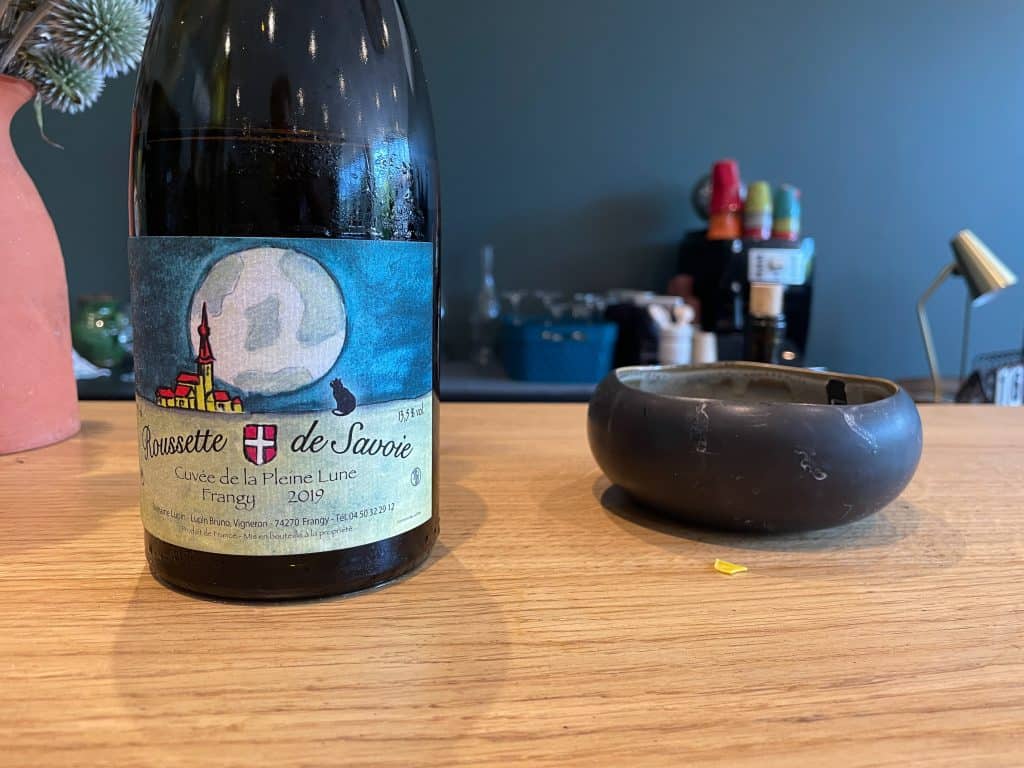
Lupin also recently began making a skin-macerated, orange version of Altesse fermented whole cluster in a tank with punchdowns that is positively brilliant and should be hitting the market shortly.
In 2015 he also began making a very unusual rendition of Altesse, half of which is aged in cask for 5 years su voile, under a blanket of flor yeast in the style of dry Sherry. The entire production of this wine was sold to a single merchant, and it wasn’t made again until 2020, so it may be a while before you come across a bottle.
Even though Cremant de Savoie must by law be made from the better-known Savoie grape Jacquere, that doesn’t sit very well with the folks in Frangy, who have been making sparkling wine from Altesse for perhaps more than a century, and don’t care to grow what they consider an unsuitable variety for their chillier meso-climate. Bruno was granted an exception to continue making his 100% Altesse Cremant de Savoie until 2020, but he says that will be the last vintage. If he decides to make sparkling wine moving forward, he’ll have to label it Vin de France.
The Anvil Overhead
When I visited Lupin last summer, the region had just been hit with crazy storms, including torrential rains and a bunch of hail in various places, causing mildew and rot to go rampant, and this after spring frosts that were particularly damaging for some. Lupin winced visibly when estimating the impact on his vineyards.
“If I am lucky, I will make enough wine to cover my interest payments,” he said. “We just have to hope this is an exception and not the trend. It’s worrying.”
The Savoie region has been hammered by adverse weather events in recent years, with significant hail damage in the 2018 and 2019 vintage. This past spring brought particularly hard frosts across most of France, including in the Savoie.
Just over a week ago on June 5th, the vineyards of the Chignin-Bergeron region were struck by a massive storm that left drifts of hailstones more than a foot deep in some places, decimating many vineyards. In a region full of small, family-run producers like Lupin, the distance between making a living and complete insolvency remains quite small.
“All I can do is try to keep back some stock of wines,” says Lupin, “So that I always have something to sell.”
Beyond that, few options exist for those who don’t have a lot of money to spend on vineyards elsewhere (to hedge their risk), or pricey technology such as electric frost protection that can only hope to mitigate the damage.
All the more reason, then, to talk about these wines, and encourage people to seek them out and support producers like Lupin, despite the wines being somewhat obscure and difficult to find.
Lupin’s wines are imported by De Maison Selections, but can be tricky to find online. I’ve provided links below for any and all I could.
Tasting Notes
2019 Bruno Lupin Cremant de Savoie, Savoie, France
Palest straw with medium-sized bubbles, this wine smells of peaches, white flowers, creme anglaise, and ripe apples. 6 g/l dosage, but I would have guessed higher. In the mouth, faintly sweet apple and white floral flavors have a nice bright crispness. Crémant legally is required to be Jacquere, but Bruno was given a special exception to use Altesse until 2020. This is the last bottling that is 100% Altesse. 12.5% alcohol. Score: around 8.5.

2019 Bruno Lupin Roussette de Savoie Cru Frangy, Savoie, France
Palest greenish-gold in color, this wine smells of green apples, dried herbs, and flowers with interestingly a faint tobacco note. In the mouth, bright apple and Asian pear flavors mix with herbal notes. Excellent acidity. 100% Altesse. 12.5% alcohol. Score: between 8.5 and 9. Cost: $20. click to buy.
2019 Bruno Lupin “Cuvee du Pepe” Roussette de Savoie Cru Frangy, Savoie, France
Pale straw in the glass, this wine smells of pastry cream, apples, and yellow herbs. In the mouth, silky flavors of Asian pear, white flowers, and wet chalkboard have an exciting vibrancy. In the mouth, the wine has incredible length, with citrus pith and yellow herbs lingering for a long time in the finish. 12.5% alcohol. Wonderfully crisp and bright. 100% Altesse made in concrete egg. Score: between 9 and 9.5. Cost: $29.
2019 Bruno Lupin “Cuvée Les Barriques” Roussette de Savoie Cru Frangy, Savoie, France
Pale straw in the glass, this wine smells of wet chalkboard, a touch of honey, and a hint of oak. In the mouth, bright stony flavors of citrus pith and dried yellow herbs mix with a hint of Asian pear and white flowers. The oak usage here seems to lean out the wine a bit, making it somewhat stonier and crisp, with a tiny hint of toasty wood in the finish. Spends six months in used Francois Freres barrels. 100% Altesse. 12.5% alcohol. Score: around 9.
2018 Bruno Lupin “Cuvée de l’Acacia” Roussette de Savoie Cru Frangy, Savoie, France
Palest greenest gold in the glass, this wine smells of white flowers and wet stones with the barest hint of gunflint that might easily get it mistaken for a Chablis. In the mouth, bright lemon pith and lemon oil mix with crushed stones and electric acidity. Silky white flowers and deep minerality. Gorgeous. There’s a precision to this wine that is positively thrilling. 100% Altesse. 12.5% alcohol. Score: around 9.5.
2020 Bruno Lupin Rosé of Mondeuse, Savoie, France
Palest coppery pink in the glass, this wine smells of raspberries and citrus peel with sweet floral notes. In the mouth, raspberry and watermelon rind mix with citrus peel and wonderfully stony minerality. There’s a faint tannic grip to it and excellent acidity. Quite delicious. 12% alcohol. Score: between 9 and 9.5.
2019 Bruno Lupin Mondeuse, Savoie, France
Light to medium garnet in the glass, this wine smells of black raspberry and aromatic herbs. In the mouth, lithe herbal, black raspberry, and mulberry flavors are wrapped in a faintly muscular skein of tannins over a wonderfully stony core of bright berry fruit with faint aromatics. Excellent acidity. 12% alcohol. Score: between 9 and 9.5. Cost: $27.
2019 Bruno Lupin “Cuvee de la Pleine Lune” Altesse, Savoie, France
Palest greenish gold in the glass, this wine smells of honeysuckle and dry tobacco. In the mouth, intense Asian pear, honeysuckle, dried yellow herbs, and wet stone flavors have a nice intensity. These grapes are left on the vine until the next full moon after the main harvest, and then family and close friends go out at night, drink wine, and harvest these rows with headlamps. The resulting wine is higher in alcohol and a bit richer, but still dry and delicious. 100% Altesse. 13.5% alcohol. Score: around 9.
2020 Bruno Lupin Orange Altesse, Vin de France
Light amber in the glass, this wine smells of marijuana and other dried herbs. In the mouth, gorgeous faintly tannic citrus peel. Dried herbs, dry tobacco, wet stones, apricot skin. Fantastic acidity. 100% Altesse spends 15 days on the skins. Bruno only made about 500 bottles. 12.8% alcohol. Not yet released or named, it will have to be labeled Vin de France as extended skin contact is not approved by the Savoie appellation. Score: between 9 and 9.5. Cost: $??
2015 Bruno Lupin “Alt 1550” Altesse, Vin de France
Light to medium gold in the glass, this wine smells of oak and citrus pith and herbs with a crushed nut quality. In the mouth, lightly tannic textures surround a core of nutty, dried citrus peel, very dry, dried herbs, and a hint of vanilla, but doesn’t taste sherried or highly oxidized. 50% of this wine ages under flor for 5 years. 13% alcohol. The entire production of this wine was purchased by a single merchant. It was next made in 2020 and has yet to be released. Score: between 9 and 9.5. Cost: $n/a
